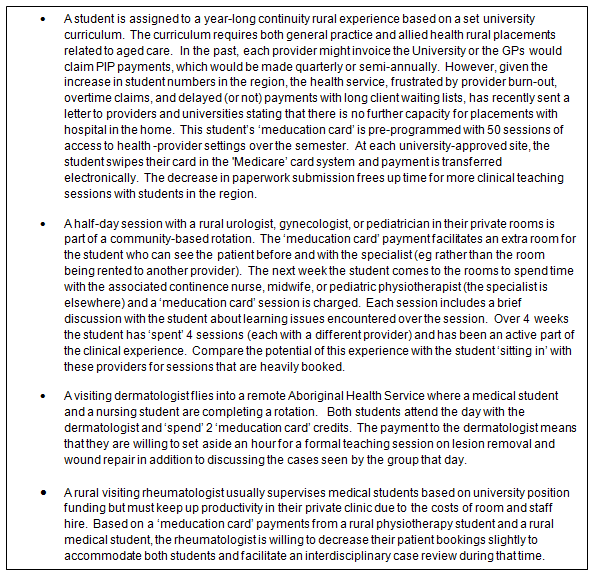Entry to practice medical programs (graduate- and undergraduate-entry) in Australia are under considerable pressure regarding clinical training placements as a result of increased student numbers1. Coincidentally, medical curricula are focussing more on meaningful, active clinical placements in expanded settings to achieve graduate medical practitioners that are fit for purpose. These dual imperatives require a mechanism to both fund and maintain the quality of clinical placements outside the traditional hospital setting.
The teaching incentive component of the Australian government's Practice Incentives Program (PIP) currently provides a student related payment of AU$100 for each half-day teaching session in a general practice setting2. General practices are paid retrospectively only if specific paperwork is filed and approved by a medical school. Payment is not specifically linked to the quality of the placement or supervision per se. Importantly, clinical placements in other settings, such as specialist or allied health professional consulting rooms, remain unsupported. The Council of Australian Governments (COAG) initiative Health Workforce Australia (HWA) is currently developing programs to support clinical placements in a wide range of health professional disciplines including medicine. The HWA has emphasized the importance of increasing the capacity and quality of clinical placements to build a larger and more effective health workforce3. One principle in this debate is that funding should follow the student and be linked to the quality and effectiveness of the placement.
A proposed solution is the development and use of a 'meducation' card to achieve this aim. The meducation card would be issued to each medical student for use during their entry to practice clinical training and would be linked to their registration with the Medical Board of Australia. The card would use the current Medicare Australia infrastructure (available in general practices, and in specialists' and allied health professionals' consulting spaces) to allow educational item numbers to be claimed for the supervisor. Educational item numbers would include supervision for a fixed period of time and provision of tutorials or case conferences, but might be expanded in the future to include funding for services provided by a senior student. In order to ensure quality, practices and/or supervisors would need to be accredited by universities in order to claim for clinical supervision. The card would include smart card technology to limit the total payments related to a particular student.
The implementation of the meducation card would immediately simplify the funding processes and improve timelines of payments related to medical student clinical placements in general practice. These might increase the number and geographical spread of available places. In addition, it would provide a mechanism by which the quality of the supervisor and placement site could be linked to funding by ensuring that only claims from accredited supervisors and sites would be processed. The nature of this accreditation process would need to be developed; however, a recent series of workshops run by HWA suggests that national standards are already under consideration4. The implementation of meducation card would also facilitate the development of clinical placements in new settings such as private specialist and allied health professional consulting and treatment rooms. This would significantly increase the opportunity for medical students to gain clinical exposure to patients with chronic diseases or acute problems not seen in hospitals. The card would also assist in a process to track students and their placements outside the hospital sector, but if successful, placements in the hospital sector and for other health professions students (ie nursing and allied health) could be included in the meducation card program with similar requirements for quality outcomes. For these and other reasons, the meducation card system would have distinct advantages when used in rural medical education in both regional and remote sites (Fig1).

Figure 1: Examples of applicability of a 'meducation card' in rural settings. PIP, Australian Government's Practice Incentives Program.
Finally, using pre-determined numbers of funded clinical training sessions would allow forward budgeting based on total student numbers. Although some might argue that a potential disadvantage of the meducation card would be an increase in the total cost of clinical placements because new settings and more supervisors would be involved; however, assuming that teaching cost and remuneration follow the student, the total number of students will determine the cost of training, regardless of mechanism. Considering the current increase in demand for these placements this may not be a major disadvantage, particularly if the payment is clearly linked to a quality outcome for the students. A 'point of education' payment model might also be the subject of fraud but this is probably no greater risk than with the entire Medicare system.
The effective education of the next generation of medical practitioners will continue to have challenges but the relatively simple implementation of the meducation card would facilitate a new era of expanded setting clinical placements in a quality framework - something well worth considering.
References
1. Van Der Weyden MB. The training Tsunami. Medical Journal of Australia 2008; 189: 353.
2. Medicare Australia. Practice Incentives Program (PIP) - Teaching Incentive. (Online) 2010. Available: http://www.medicareaustralia.gov.au/provider/incentives/pip/index.jsp (Accessed 31 August 2010).
3. Health Workforce Australia. Mission statement. (Online) no date. Available: http://www.hwa.gov.au/about/mission-statement (Accessed 31 August 2010).
4. Health Workforce Australia. Clinical Supervision Support Program - National Forums. (Online) 2010. Available: http://www.hwa.gov.au/news/11-08-2010/clinical-supervision-support-programnational-forums-video-available (Accessed 10 September 2010).

